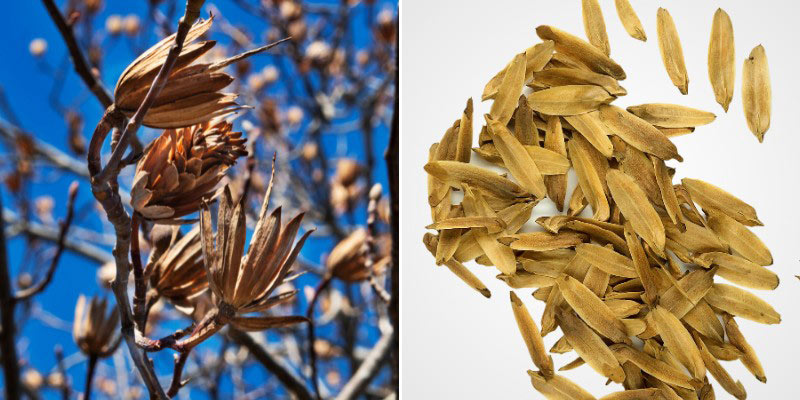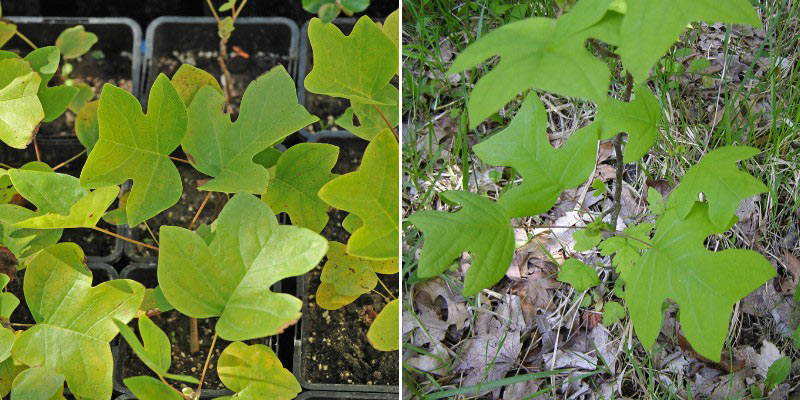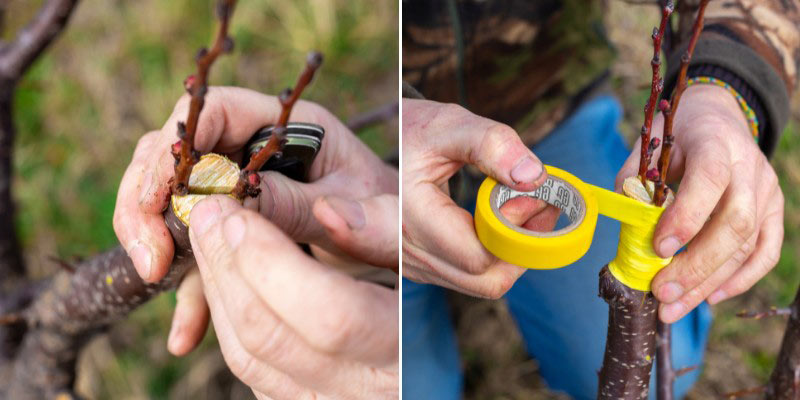Tulip tree, also called Liriodendron tulipifera, is a very beautiful plant valued for its tulip-shaped flowers and truncate leaves that turn golden in autumn before falling. In summer it produces large flowers opening into broad tulips, pale green to yellowish, with a lemony scent. Leaves are generally green but can also be marginate with yellow as in variety 'Aureomarginatum'. Tulip tree can reach between 15 and 25 m at ripeness and forms a lovely conical crown (or columnar in variety 'Fastigiata'). It is long-lived, capable of living for more than 400 years. It looks superb in garden, whether as a specimen in the middle of a short grass meadow or as an alignment tree. In this tutorial we explain how to multiply it by sowing and by grafting.
For everything about its cultivation, discover our full fact sheet: "Tulip tree, Liriodendron: planting, care".
Propagating Tulip tree by sowing
Sowing is the simplest method to propagate Tulip tree, but it is also the longest, as it can take several years before seedlings are large enough to plant out.
In autumn, after flowering, Liriodendron produces cones that contain many winged seeds. Once cones are fully dry and brown, you can harvest them and collect the seeds for sowing.

When to sow Tulip tree?
Sowing of Tulip tree is done in autumn or in spring. Seeds must be stratified, that is exposed to a period of cold, to germinate. You can either place them in the refrigerator for 3 to 4 months to sow them in spring (this technique is described below), or sow them directly in autumn and leave the pots outdoors over winter.
Material needed
- Seeds of Tulip tree
- Pots
- Special sowing compost, or a mix of compost and sand
- A watering can fitted with a rose
- Labels
How to sow?
Tulip tree seeds need a period of cold to germinate : they must therefore be stratified. To do this, mix seeds with damp sand and place them in a plastic bag or airtight container. Keep the mixture in the refrigerator for 3 to 4 months. You can then proceed to sowing:
- Fill pots with special sowing compost.
- Sow seeds on the surface, then cover with a thin layer of substrate. They should be sown at a depth of about 5 mm to 1 cm.
- Firm down lightly and water with a fine spray, using a watering can fitted with a rose or a mister.
- Place the pot under cover, in a bright spot but out of direct sun, ideally at a temperature of 25 to 30 °C.
- Germination can take 3 to 6 weeks, or even several months.
- When seedlings have reached a sufficient size (around 10 cm tall), pot on into individual pots.
- Keep them in pots for one to two years before planting out in the ground.

Propagation by cuttings of Tulip tree
When to take cuttings of Tulip tree?
Propagation by cuttings of Tulip tree is preferably done in late summer (August–September).
Materials needed
- A pruning shear sharpened and disinfected
- Pots
- Special compost for sowing and propagation by cuttings
- Rooting activator (facultative)
- A watering can with a rose
How to proceed?
- Take cuttings 10 to 15 cm long from semi-ripe shoots of the year (upper part still tender and lower part slightly lignified). Cut just below a node (point where leaf is inserted on stem).
- Remove leaves from the base of the cuttings, keeping only one or two at the tip of the stem. Cut these in half to reduce foliar surface and thus prevent the cuttings from drying out.
- Dip the base of the cuttings in plant hormone rooting powder.
- Plant the cuttings in an equal mix of compost and sand, ensuring the lower half of the cutting is buried. It is important not to delay between taking cuttings and planting them in the substrate, as shoots wilt quickly because of Tulip tree's large foliar surface.
- Keep the soil moist and place cuttings in a warm, shaded spot.
- Rooting can take several weeks. Once cuttings have developed solid roots, pot on into individual pots. Keep them in pots for one or two years before planting out in the ground.

Propagate Tulip tree by grafting
Grafting is a slightly more technical method to propagate Tulip tree, and is intended for more experienced gardeners. A cleft graft or a shield graft can be practised.
This technique is ideal for preserving characteristics of variegated or fastigiate varieties, which sowing does not allow.
When to graft Tulip tree?
Grafting of Tulip tree is carried out in late winter or early spring (February to April), when sap begins to rise.
Materials needed
- A pruning shear
- A grafting knife sharpened and disinfected
- Grafting tape
- Grafting sealant
How to graft Tulip tree?
There are different grafting techniques; the most common for Tulip tree is the cleft graft. It is also possible to do an English graft or a shield graft. Use as rootstocks young tulip trees one or two years old obtained by sowing, and as scions the variety whose characteristics you wish to preserve.
- Select a healthy, vigorous rootstock about 1 to 2 cm in diameter.
- Choose scions with active, healthy buds coming from the Liriodendron variety you wish to reproduce.
- Cut the rootstock to about 30 cm above ground.
- Make a vertical cut in the centre of the first cut, about 2 to 3 cm deep. Gently spread the two parts to form a cleft.
- Prepare scions by cutting them on a bevel on two sides. Ensure scion length matches depth of the cleft.
- Insert one or two scions into the cleft, ensuring the cambium (the layer of living tissue beneath the bark) of the scion is in close contact with that of the rootstock.
- Secure scions in place with grafting tape.
- Cover the graft with a healing sealant to prevent desiccation and infection.
- Keep the scion in the shade and water regularly during the first weeks.
- Check graft union after a few weeks by pulling gently on the scion. If it resists, the graft has taken.
- Once graft successful, cut the rootstock above the scion to encourage growth of the new variety.

































Comments